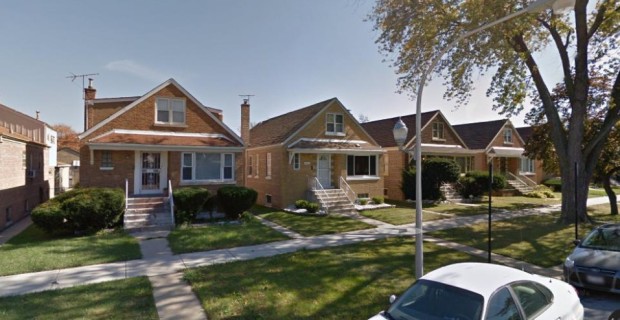As I’ve written before, the South Side is a much more diverse place than people give it credit for. This is true both in the ethnic sense – you can find Asian, Hispanic, white, black, and, yes, integrated neighborhoods there – and in the sense that for each of these ethnic categories, there’s a range of economic conditions.
Pete Saunders has a nice post reminding people of this second fact, by pointing out that the kids on the Jackie Robinson Little League team (and US champions, by the by) mostly come from neighborhoods that don’t actually fit the storyline some media outlets have chosen to put on them. That is, they did not all emerge from broken homes, dodging bullets as they cut through trash-strewn lots to the baseball diamond, which was the one outlet they had to seek relief from their impoverished ghetto.
No, in fact, this is what the houses across the street from Jackie Robinson Park look like:
And here’s a random block from a few streets away:
If you look at the maps of the black middle class I made a bit ago, you can see the far South Side neighborhoods that make up the area around Jackie Robinson Park lit up in blue:
Now, that’s not to say that these neighborhoods don’t have problems. Like many, if not most, working- and middle-class neighborhoods in America, they’ve seen significant losses of well-paying jobs over the last several decades. Like most black neighborhoods in America, they’ve been shaped by a legacy of segregation that’s dramatically increased the concentration of poverty there, compared to working- and middle-class neighborhoods that aren’t black, and they have some of the issues that come with relatively higher poverty rates, like relatively higher crime rates. But they’re also, as Pete points out, not generally dangerous in the way that outsiders imagine every black neighborhood on the South Side is.
Roseland – one of the neighborhoods where a lot of the Robinson players are from – also happens to be home to Gwendolyn Brooks College Prep, which Chicago Magazine named the fifth-best public high school in the city, just below the four super-elite test-in academies, and higher than another North Side selective-enrollment school, Lane Tech. Its average ACT score is even with Niles West, a well-regarded north suburban school that serves a significantly more affluent population.

Near Brooks is Poe Elementary, which that same issue of Chicago Magazine ranked as the fifth-best public elementary school in the city, above many of the neighborhood schools – and even a handful of selective enrollment schools – in places like Lincoln Park and Lakeview that have become the default option for the city’s “global city” class. Three other Far South Side schools made the top ten, two of them in black neighborhoods.
There’s something to all this – to my laying out the case that you should think of the South Side as a place where people live, and where they accomplish things that they and other people find admirable, like keeping tidy lawns, or playing baseball extremely well, or supporting high-achieving schools – that’s very noxious. That is to say, it assumes that a) the personhood, and respectability, of these people is in doubt, and b) that the esteem of the people who doubt it – the North Siders and suburbanites and newspaper writers and readers all around the country – is necessary, that it’s not enough that the residents of these neighborhoods are, in fact, people.
My indignance – not to mention the prospect of freeing up more time to write about things that shouldn’t be obvious – makes it tempting to declare that the esteem (or, at the moment, the ignorance) of the rest of the world doesn’t matter. Unfortunately, that’s plainly not true.
Brooks College Prep, the fifth-best public high school in the city, was at the receiving end of that ignorance last year, when parents from Walter Payton College Prep (number two on Chicago Magazine’s rankings) forfeit a game of baseball because they were too terrified of Roseland to allow their children to go to Brooks’ campus to play.
And if Payton parents – whose views, I imagine, are broadly representative of those “global city” households downtown and on the North Side, and in analogous neighborhoods across the country – won’t go to Roseland on a chartered bus to play a scheduled high school baseball game at one of the city’s elite selective enrollment high schools, they’re certainly not going there to spend any money at the local businesses, or to open businesses, or to visit the local sites, like the Pullman Historic District. Their ignorance demands that these places, and these people, be completely shunned.

And while the parents themselves certainly deserve some blame for this, I’m going to go ahead and add it to the j’accuse from “The Dignity of Fifth-Graders” and ask that media outlets in Chicago and nationwide consider how their coverage of crime on the South Side has contributed to this situation. If you spend years telling your readers that the South Side is a “war zone,” then you don’t get to be surprised when your readers treat it like a war zone.
We don’t get to celebrate one baseball team’s worth of black kids from the South Side while we’re shunning all the rest.


